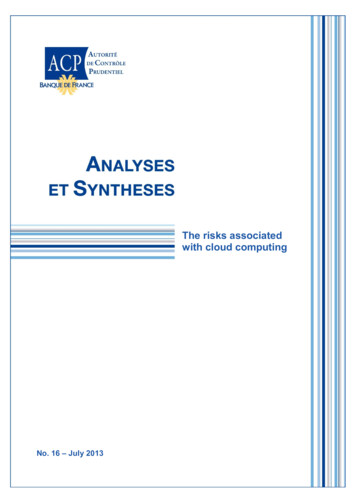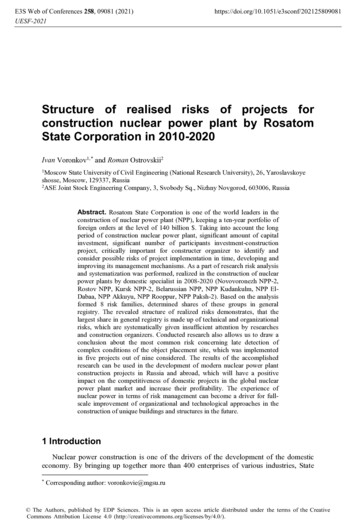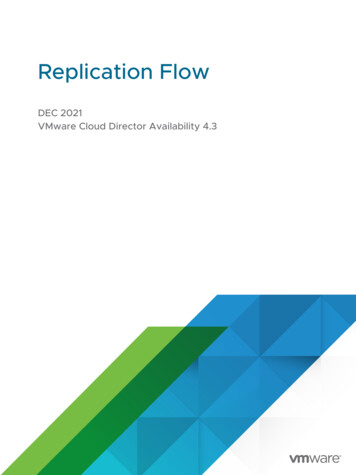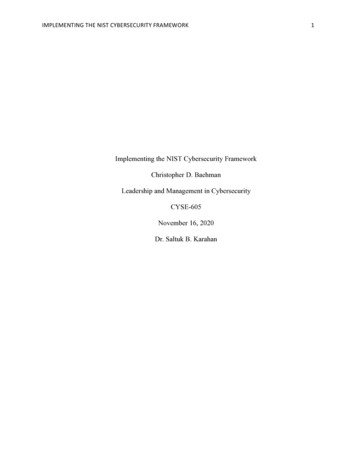
Transcription
The risks associatedwith cloud computingNo. 16 – July 2013No. 16 – July 2013
Table of contents1. CHARACTERISTICS OF CLOUD COMPUTING.51.1.Defining elements .51.2.Clarifications on the definition criteria .61.3.Distinction between cloud computing and conventional outsourcing .72. IMPLEMENTATION OF CLOUD COMPUTING SERVICES .72.1.Economic issue .72.2.Expected benefits .82.3.Perceived risks for the banking and insurance sectors .82.4.Frequent use in the fields of management and IT support .102.5.Decision to commit to a cloud computing service .103. REQUISITE ACCOMPANYING MEASURES .114. ADEQUACY OF THE REGULATORY ENVIRONMENT .125. KEY LESSONS AND GOOD PRACTICES THAT CAN BE IDENTIFIED .13APPENDIX: SURVEY ON CLOUD COMPUTING (QUESTIONNAIRE SENT OUT).17Purpose of the survey .171. Characteristics of cloud computing .172. Uses of cloud computing .183. The legal environment of cloud computing .184. Risks and security measures associated with cloud computing .192
Abstract:Information systems are of strategic importance in both the banking and insurancesectors. The development of cloud computing is a recent advance that has becomea subject of attention.1Cloud computing is defined as a "method of processing a client's data, which areexploited via the Internet in the form of services provided by a service provider.Cloud computing is a special form of information technology (IT) outsourcing, inwhich end users are not informed of the location or internal structure of the cloud."This topic is particularly current for a number of regulatory bodies. In France, theAgence Nationale de Sécurité des Systèmes d’Information (ANSSI – FrenchNetwork and Information Security Agency) is working on regulation via acertification mechanism. In 2012 the Commission Nationale de l’Informatique etdes Libertés (CNIL – French Data Protection Authority) issued recommendationsfor companies considering subscribing to cloud computing services. Abroad, manysupervisory authorities have issued statements (the United States of America,Singapore, the Netherlands), or imposed a system of prior authorisation (Spain) forthe use of this technology.In this context, the Secrétariat général de l’Autorité de contrôle prudentiel (SGACP– General Secretariat of the Prudential Supervisory Authority) conducted a shortsurvey to engage in a dialogue with companies in the banking and insurancesectors on the scope, use and risks of cloud computing. A total of 14 companiesfrom the insurance sector and 12 from the banking sector responded to aquestionnaire at the beginning of this year, providing a representative view onthese topics.The first idea that emerged from this dialogue was a need to clarify the concept ofcloud computing by offering a multi-criteria definition, inspired by that given by theAmerican National Institute of Standards and Technology (NIST). The SGACPtherefore proposes to describe these services as follows: cloud computing consistsin using remote servers to store and process data traditionally located on localservers or on the user's terminal; it enables on-demand and self-service networkaccess to virtualised and pooled computing resources typically charged for on apay-per-use model; three types of services are offered (IaaS – Infrastructure as aService, PaaS – Platform as a Service, SaaS – Software as a Service), deployedaccording to four models (internal private cloud, external private cloud orcommunity cloud, public cloud, hybrid cloud).The credit institutions and insurance undertakings (companies) responding to thequestionnaire confirmed that cloud computing poses greater risks compared toconventional IT outsourcing. The numerous risks identified include data privacy,unavailability of data and data processing, loss of integrity (especially the risk ofnon-reversibility or lock-in) and finally the area of evidence and control. They agreeon the need for a stronger legal environment, the need for certain technical securitymeasures, the need to audit the service provider, the need for the provider tocommit to continuity of service and, finally, the need to obtain a guarantee from theservice provider on the reversibility of the service.However, opinions differ on the importance of the economic aspects surroundingcloud computing, with many companies claiming that security considerationsshould prevail in analysing its value. Moreover, it is noted that an overwhelmingmajority of companies use cloud computing in management areas consideredoutside the "core business", even if use in more sensitive areas is also beginning toemerge. It also appears that there are differences in the procedures for theadoption of cloud computing between the insurance and banking sectors.1“Vocabulaire de l’informatique et de l’internet”, in the Official Journal of the French Republic No. 129 of6 June 2010.3
As a result of this initial analysis, which shall be refined as changes in the use andthe risks of cloud computing are observed, the Autorité de contrôle prudentiel (ACP– Prudential Supervisory Authority) is encouraging the companies it supervises totake suitable risk management measures in respect of the following aspects: Legal: by enforcing a mandatory contractual framework for cloud computingservices; Technical: by encrypting data during transport and storage (in the absence ofanonymisation); Supervision of the service provider: by ensuring audit capability and the right forthe ACP to conduct audits; Continuity of the service: by ensuring that the expectations of the clientcompany can be formalised in service contracts; Reversibility of the service: by defining the conditions of reversibility whensubscribing to the service; Integration and architecture of information systems: by adapting theorganisation and governance of information systems to the use of cloud computing.These good practices form part of the broader framework defined for thesupervision of outsourced services, including conventional outsourcing. Theexpectations of the ACP in terms of governance of decisions, risk analysis,contractual elements, monitoring and the internal control of cloud computingservices are therefore similar to those currently in force in prudential supervision.Study carried out:- For the SGACP by Marc Andries (On-site Inspection Delegation), GuillaumeCassin (Supervision of Mutual Institutions and Investment Firms Directorate),Ayoub Bahhaouy, François Philippe and Yannick Foratier (Cross-Functional andSpecialised Supervision Directorate);- For the Organisation and Information Systems (OI) of the Banque de France, byAndres Lopez Vernaza and Franck Rigodanzo.Non-binding translation4
THE RISKS ASSOCIATED WITH CLOUD COMPUTINGInformation systems are a strategic element in the proper functioning and stabilityof the banking and insurance sectors. The field of IT is also constantly evolving astechnologies and solutions are constantly being renewed.From among recent advances, the development of cloud computing, a new form ofIT outsourcing, has become a focal point for the ACP.This type of service consists in moving the mass processing of data and/orsoftware to a service provider and accessing these via a network such as theInternet. In France, ANSSI discussed cloud computing in its Guide pourl’externalisation (Guide to Outsourcing, 2010) and is working on regulating thecloud via a certification mechanism. In 2012 the CNIL issued recommendations forcompanies considering subscribing to cloud computing services. In the financialsector abroad, the Federal Financial Institutions Examination Council issued astatement in July 2012. The Monetary Authority of Singapore updated itsTechnology Risk Management Guidelines in June 2012 to include cloudcomputing. In Europe, the Banco d’España and the De Nederlandsche Bank havepublished their positions on cloud computing.In this context, the SGACP conducted a short survey to engage in a dialogue withcompanies in the banking and insurance sectors on the scope of cloud computing,the extent to which this type of solution is used, their awareness of risks and thesecurity policies adopted, as well as the suitability of the current regulatoryenvironment. A total of 14 companies from the insurance sector and 12 from thebanking sector responded to the survey, giving a representative view on thesetopics.This study gives the industry a report of the responses to the survey, administeredin the form of a questionnaire (see Appendix). It describes a number of goodpractices, the implementation of which shall be examined by the SGACP, whileclosely monitoring the developments of risks associated with cloud computing.1. Characteristics of cloud computing1.1. Defining elementsThe term cloud computing covers a variety of types of services likely to continue toevolve over time as new technical solutions emerge. In order to avoid theconstraints of a framework that may quickly become obsolete, the SGACP choseto adopt a definition on the combination of different criteria, including thoseproposed by the NIST in the United States. The respondent companies confirmedthat they agreed with the proposed definition criteria.This definition, repeated below, describes the general concept of cloud computing,the types of services offered and the various deployment models reflecting therelationship between the client company and the service provider: Concept: cloud computing consists in using remote servers to store andprocess data traditionally located on local servers or on the user's terminal. Itenables on-demand, self-service access via a network, usually understood to bethe Internet, to virtualised and pooled computing resources typically charged for ona pay-per-use model. Services: in its most common forms, cloud computing provides three types ofresources.5
Infrastructure as a Service (IaaS) offers IT infrastructure such as computingpower, virtual machines including an operating system, storage, and backupservices. Platform as a Service (PaaS) provides an integrated development and/orruntime platform, based on a catalogue of standardised software and technicalcomponents whose underlying infrastructure is invisible to the user. Software as a Service (SaaS) is an application-based solution addressing aspecific field of use supporting a business function (customer relationshipmanagement, financial management, etc.) or a cross-functional service(messaging, collaborative tools, etc.) Models: cloud computing is deployed according to four models: Internal private clouds are managed internally by a company for its own needsand on infrastructure that it owns. External private clouds are dedicated to the needs of one company or a groupof companies but are hosted by a service provider. Public clouds are managed by specialised companies that lease their servicesto many companies. The word "public" here refers to the meaning commonly usedby cloud computing stakeholders, that is to say an open and multi-clientenvironment. Finally, hybrid clouds dynamically combine public and private clouds.Public clouds are a special form of IT outsourcing in which services are pooled fora large number of customers and customers are usually not informed of thelocation of data in the "cloud".Naturally, the ACP’s attention is mainly turned to the development of publicor hybrid cloud services for banks and insurance companies: in these types ofcloud, pooled services are made available to all customers and/or internal users,creating a risk of data permeability between different beneficiaries. However, thesame can be said for any external private cloud model in which services providedto a company under the supervision of the ACP are pooled with those offered toother customers, even within the banking and insurance sectors. This is true ofcommunity clouds, for example, in which resources are shared among a limitednumber of partners.1.2. Clarifications on the defining elementsWhile approving the defining elements proposed by the SGACP, some companieschose to add a few clarifications regarding the specific characteristics of cloudcomputing.Pooling of geographically dispersed resources. Large international groups, inthe insurance and banking sectors alike, recognise cloud computing as a means toextensively pool their resources without requiring specific developments. Doing sowould greatly simplify multi-country and multi-entity deployment. One largeinternational banking and insurance group also indicates that this practice enablesdata to be distributed over geographically dispersed data centres and ensures theavailability, as backup, of many employees who are also geographically dispersed.Greater adaptability of resources. One banking group emphasises the conceptof service elasticity and the fact that with cloud computing, requested IT resourcesare automatically made available. According to one insurance group, the real-timeadaptability of information systems is a prime characteristic of cloud computing.Not all respondents agree on the concept of self-service, which minimisesinteractions between the customer and the supplier in the provision of a service6
(ready-to-use services depending on service levels): one insurance groupquestions the suitability of this term, since a contract must be signed in order touse the cloud computing service.One respondent considers the proliferation of definitions of cloud computing to beproof that the concept is not yet stabilised, in particular with respect to "datafragmentation".1.3. entionalA large majority of companies consider cloud computing to be one particularmethod of IT outsourcing, and therefore it presents many of the same features andrisks as conventional outsourcing. One large banking group even suggests thatdue to the industry’s requirements with regard to cloud computing, in practice,cloud services may grow to resemble conventional outsourcing.However, the opinion overwhelmingly shared with the SGACP is that cloudcomputing presents greater risks than conventional outsourcing.Specific features that are often underlined are the greater scalability and flexibilityof use of cloud computing, (such as that provided by the pay-per-use model)compared to conventional outsourcing. Conversely, cloud computing implies a lossof influence on the part of the client companies with regard to IT service providers:- Cloud computing stakeholders rarely commit to an obligation of results butprefer an obligation of means, with weak or non-existent service level agreements(SLAs) in the cloud computing world being one clear indicator of this.- Respondents highlight a loss of flexibility in designing the service offer: whereconventional outsourcing makes it possible to receive a response tailored to statedexpectations, for the time being, cloud computing only offers generic solutions.- Respondents clearly fear a partial loss of control of the information system, dueto loss of control of data (no knowledge of the location or resilience of the service)or dependency on service providers. With cloud computing services, maintainingoperational readiness is routinely performed by the service provider: the tasks ofmanaging developments, acceptance testing and planning rules are theresponsibility of the supplier, as is the execution of version upgrades, which aresometimes carried out without even informing the client organisations.2. Implementation of cloud computing services2.1. Economic aspectsThe SGACP sought to measure the level of enthusiasm for these services, inparticular due to the potential economic benefits, on which the viewpoints appearto be divided.Some respondents attest to reduced costs (in particular due to the pay-per-usemodel) and shorter implementation time frames, while warning of hidden costs thatmay ultimately diminish these benefits. One international banking group also notesthat cloud computing can facilitate exchanges between partners, for example whensynchronising export operations (the documentary credit workflow). Anothercompany hopes to reduce infrastructure and implementation costs and streamlinethe management of its business continuity plan.Without denying these theoretical economic benefits, others consider that thedecision to use cloud computing or not should be guided by the associated risks.7
2.2. Expected benefitsMore flexible solutions. The speed of implementation, ease of management,flexibility and elasticity of cloud computing solutions are the key elements that arehighlighted. Some companies emphasise the availability, performance, broadaccessibility and increased mobility of cloud computing solutions, for which all thatis required is a simple Internet connection. Cloud solutions would therefore be anadvantage in areas requiring high computing power over limited periods, ininsurance and reinsurance (modelling and pricing) as well as investment banking(risk calculations). One insurer cites IT developments with a limited lifespan as apotential target for cloud computing because of the required implementation timeframes. A few respondents indicate, however, that this flexibility is still limited andthat for the time being, cloud computing solutions will remain standard solutions orinsufficiently developed or mature, since there is still too little available feedback.Better access to cutting-edge technology. Cloud computing solutions are oftenassociated with the latest technologies based on standard and interoperablecomponents. Companies that feel they do not have the necessary critical mass,resources or expertise see a chance to benefit from an environment that willalways remain state-of-the-art and comply with the requirements of customers andregulators. For a small bank, cloud computing enables the use of up-to-date andenergy efficient data centres. With respect to the applications available throughcloud computing, a number of companies hope to benefit from the latest featuresand updates as well as more consistent functions thanks to pooling andcentralisation. One large international banking and insurance group believes,however, that the benefits of cloud computing are limited to "utility" and low-riskservices and are similar to those of "off the shelf" solutions.Reduced IT costs. Cloud computing should also represent a benefit in terms ofcost, particularly thanks to the pay-per-use model and billing at full costs. Morebroadly, some companies are announcing a change in the economic model and adrop in investment, seen as an advantage by companies with tight budgetconstraints on investments, but less on operating budgets. One major internationalbanking and insurance company sees an opportunity in cloud computing to removea number of development and operating costs with low added value from internalinformation systems in order to focus its resources on needs with higher addedvalue. Another sees the possibility of reducing its infrastructure management costs.The financial benefit argument must, however, be put into perspective. Indeed,conversely the hidden costs of cloud computing are highlighted; these are causedby difficulties interfacing and integrating the subscribed service with the company'sIT infrastructure, as well as the impact in terms of human resources and theprocesses of SaaS solutions.However, the supposed advantage conferred by the cloud is not unanimouslyappreciated: one large banking institution and one insurance company do not seeany benefit in cloud computing.2.3. Perceived risks for the banking and insurance sectorsAll of the companies appeared susceptible, albeit to varying degrees, to thespecific risks arising from the use of cloud computing. To a large extent these risksare a hindrance to the use of this technology, particularly in the case of public andhybrid clouds. The main obstacle seems to be rooted in the very limited room fornegotiation when taking out the contract for the services offered, which are mostlygeneric. Thus organisations are finding it difficult to obtain specific arrangementsaddressing the risks they have identified.8
The data privacy risk is the one that is overwhelmingly highlighted. The weaknessof security solutions (including on-the-fly encryption and management ofcryptographic keys) is generally listed first. The lack of knowledge about the2location of data or the right to access data in favour of certain States is considereda severe regulatory risk: within a pooled infrastructure that can potentially beaccessed by local regulators it is difficult to ensure compliance with regulatoryrequirements, such as those resulting from regulations on banking secrecy and theprotection of personal data and more widely in terms of intellectual property. Thisrisk would be further increased outside the European Union. One largeinternational group even sees a sovereign risk in this (if the data and dataprocessing of French companies were no longer located in France). Difficultycontrolling data security throughout the supply chain, given the number ofstakeholders likely to be involved in the provision of the service, is also noted. Thesame applies to the difficulty ensuring that the service provider cannot readconfidential data through its systems' event logs. Difficulties of integration with thecompany's information system and the risk of proliferation of clouds interfaced withthe information system are also highlighted as potential barriers; one bank evenconsiders that the interconnection between its own information system and that ofthe cloud computing service provider may create a security breach. Finally, anotherbanking group points to the difficulty of ensuring that the service provider hasdestroyed data when the service is terminated.The unavailability of data and data processing is another risk often mentionedby respondents, who highlight a gap between the need for continuity of service andthe concept of availability of service used by cloud computing providers. Onecompany states that the supplier commits to an availability rate, but that noncompliance is only sanctioned by financial penalties. Some insurance groupsconsider that the tangled web of service providers entails a risk when it comes toidentifying the entity responsible for the service and thus a weakening of the SLA.For that matter, several companies point out that the contractual commitment ofthe cloud computing service provider on the availability of the service must be putinto perspective since the latter cannot guarantee the speed, and in certaincircumstances even the availability, of the internet network, which, however, is akey element for availability of the application.The loss of integrity, whether concerning the data or processing, is not explicitlymentioned but is apparent in the answers. Some fear for the overall integrity oftheir information system due to a loss of technical expertise, or even dependenceon one supplier. Finally, the risk of non-reversibility or "lock-in" is seen assignificant, particularly to the extent that it is difficult to assess the ability of theservice provider to return the data in a usable format. One banking group notesthat it will be difficult to re-internalise a service if the service provider's tools andformats are proper to the latter.The weaknesses of cloud computing in the area of control and evidence arealso identified by a large number of respondents. The difficulty of auditing a serviceprovider, or obtaining a right to audit, due to the proliferation of stakeholders andtheir geographical location is highlighted. More generally, the difficulty of setting upan adequate internal control system is emphasised by one large internationalbanking and insurance company. Some insurance groups note the increased riskof non-compliance, particularly because of the location of data and identification ofthe applicable law.2The case of the Patriot Act of the United States of America is often cited as an example. It allows USsecurity services to access personal data on their territory or abroad if they are held by US companies.Moreover, a recent report by the European Parliament (2012) indicates that the Foreign IntelligenceSurveillance Amendments Act (FISAA), specifically focused on data from non-US persons locatedoutside the United States, is likely to give a right of access to US government agencies to all data storedin the cloud.9
Even if this type of service does indeed imply specific risks, the vast majority ofcompanies reported that they use conventional risk analysis methods for analysingcloud computing solutions. However, some have supplemented their methodologywith scenarios specific to cloud computing risks. One large banking groupconsiders, for example, that an architecture risk is intrinsic to cloud computingowing to its integration into the company's information system. In the same vein,other respondent voices the idea that pooling means that exploitation of a securitybreach on one client could have a negative impact on other clients hosted by theprovider.Conversely, one small banking institution reported that cloud computing couldenable it to access a higher level of security than it could implement itself.2.4. Frequent use in the fields of management and IT supportThe level of use of cloud computing solutions is ultimately consistent with theadvantages and disadvantages that have been highlighted. However, these3solutions, already commonly used, are limited to support activities for the timebeing, although some companies are willing to make wider use of them.Overwhelmingly, cloud computing is used in management areas consideredoutside the "core business", but without providing a definition of this term, suchas human resources, finance (expense reports), procurement or external orinternal communications (corporate social networks, messaging, calendars, webconferencing, document sharing). Some major insurance groups report that theapplications that could constitute a competitive advantage are not designed to belocated in the cloud. Other companies claim to use cloud computing depending onthe confidentiality and location of the data, while recognising they do not have anyguarantee on compliance with the confidentiality of data, notably outside Europe.However, use in more sensitive areas is also beginning to emerge. Oneinsurer says it uses a hybrid SaaS solution for its accounting while another usesthe cloud to host data on regulatory compliance, accounting, finance, treasury andinvestment. Several major banking groups use cloud computing services forcustomer relationship management in retail banking, corporate and investmentbanking and financial services. One banking group says it uses cloud computing inthe field of adverse possessions. Other major groups are using cloud computing forhosting institutional websites or for services related to IT security (filtering ofinternet access). Some insurers report they do not rule out the use of cloudcomputing solutions to meet infrastructure needs for development or testingpurposes (planning phase).2.5. Decision to commit to a cloud computing serviceThe answers suggest there are differences in the procedures for the adoption ofcloud computing between the insurance and banking sectors.The choice to use cloud computing in insurance would involve, in the vast majorityof cases, the Board of Directors or the Executive Committee. The adoption of cloudcomputing for sensitive or "core business" data would also require approval fromthe Board of Directors. Another insurer reports that this decision would be theresponsibility of its Information Systems department.On the banking side, the process of adopting cloud computing follows the processof development of the information system with an initiative from the business linesor support functions and project management by the IS department following a riskanalysis.3Approximately half of the insurance companies that responded are using a cloud solution, of whichtwo-thirds are the equivalent of a private cloud. This information is not directly available for the banks,but by comparing various data the orders of magnitude appear to be similar.10
In this process, the Heads of Information Systems Security and IT services advisethe business lines and examine the conditions for integration of the service withinthe information system. One large banking group indicates that in the case of asignificant enhancement, the strategic committee would be called upon. A mutualgroup reports that the decision to commit to a cloud computing service could onlycome from the Information Systems department. A small bank reports that thisdecision would be taken by its Managing Director in consultation with the Head ofInformation Systems Security.3. Requisite accompanying measuresAs current cloud computing solutions seem to offer little guarantee in terms ofcompliance with provisions relating to the protection of personal data, the need fora more secure legal environment is clearly a point of agreement. Furthermore,certa
sectors. The development of cloud computing is a recent advance that has become a subject of attention. Cloud computing is defined1 as a "method of processing a client's data, which are exploited via the Internet in the form of services provided by a service provider. Cloud computing is a special form of information technology (IT) outsourcing, in











